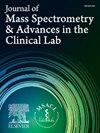蛋白沉淀-免疫亲和富集- lc -MS/MS定量胰高血糖素和氧合调节素
IF 3.4
4区 医学
Q2 MEDICAL LABORATORY TECHNOLOGY
Journal of Mass Spectrometry and Advances in the Clinical Lab
Pub Date : 2025-04-01
DOI:10.1016/j.jmsacl.2025.04.002
引用次数: 0
摘要
胰高血糖素和氧合调节素是胰高血糖素原释放的肽激素,具有调节血糖的作用。它们重叠的氨基酸序列使特异性免疫测定的发展变得困难,但液相色谱-串联质谱法的特异性可以用来区分肽。我们的目标是开发一种敏感和特定的质谱分析方法,该方法使用非专有试剂和正常流动液相色谱法同时定量分析这两种分析物。方法用乙醇/氢氧化铵沉淀血浆蛋白。分析物使用内部生成的单克隆抗体进行富集,并使用液相色谱-串联质谱法进行分析。通过高效液相色谱-紫外检测和氨基酸分析对胰高血糖素的纯度和浓度进行了表征。采用单点校准以尽量减少日之间的变化。结果新抗体的多肽回收率为45 ~ 59%,表现良好。测定胰高血糖素和氧同调素的准确度(13% CV)在1.3-14.7 pM和1.1-13.7 pM范围内呈线性。测定胰高血糖素校准物质浓度为1.596 mg/g。管型研究支持在抽血时使用蛋白酶抑制剂管。1型糖尿病患者维持胰岛素泵时胰高血糖素浓度较低,而注射胰岛素时则没有。结论本方法具有非常详细的标准操作规程。我们对校准材料进行了表征,以帮助保持准确性并实现日与实验室之间的协调。该试验将有助于更好地了解糖尿病和其他疾病的α-细胞健康和血糖控制。本文章由计算机程序翻译,如有差异,请以英文原文为准。
Quantification of glucagon and oxyntomodulin by protein precipitation-immunoaffinity enrichment-LC-MS/MS
Introduction
Glucagon and oxyntomodulin are peptide hormones differentially released from proglucagon that function in regulating blood glucose. Their overlapping amino acid sequences make the development of specific immunoassays difficult, but the specificity of liquid chromatography-tandem mass spectrometry can be used to distinguish the peptides. We aimed to develop a sensitive and specific mass spectrometric assay that uses non-proprietary reagents and normal-flow liquid chromatography in the simultaneous quantification of both analytes.
Methods
Bulk plasma proteins were precipitated in ethanol/ammonium hydroxide. Analytes were enriched using monoclonal antibodies generated in-house and analyzed using liquid chromatography-tandem mass spectrometry. A glucagon calibration material was sourced commercially and characterized for purity and concentration by high-performance liquid chromatography-ultraviolet detection and amino acid analysis. Single-point calibration was used to minimize between-day variability.
Results
The novel antibodies performed acceptably (peptide recovery 45–59 %). The assay was precise (<13 %CV) and linear over the range of 1.3–14.7 pM and 1.1–13.7 pM for glucagon and oxyntomodulin, respectively. The glucagon calibration material concentration was determined to be 1.596 mg/g. Tube-type studies supported the use of protease inhibitor tubes at the time of blood draw. Patients with type 1 diabetes had lower concentrations of glucagon when maintained on an insulin pump, but not with injectable insulin.
Conclusion
We have validated a method with a highly detailed standard operating procedure. We have characterized calibration materials to help maintain accuracy and achieve between-day and between-laboratory harmonization. The assay will be beneficial in better understanding α-cell health and glycemic control in diabetes and other diseases.
求助全文
通过发布文献求助,成功后即可免费获取论文全文。
去求助
来源期刊

Journal of Mass Spectrometry and Advances in the Clinical Lab
Health Professions-Medical Laboratory Technology
CiteScore
4.30
自引率
18.20%
发文量
41
审稿时长
81 days
 求助内容:
求助内容: 应助结果提醒方式:
应助结果提醒方式:


